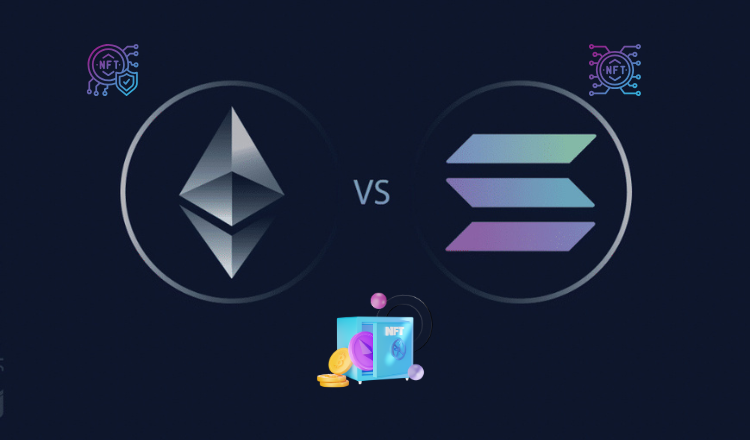Ethereum vs. Solana NFT in 2025: Which Blockchain Truly Dominates the NFT Space?
Non-Fungible Tokens (NFTs) continue to reshape the digital asset landscape in 2025. As Web3 projects flourish and creators thrive in decentralized ecosystems, two major blockchains—Ethereum and Solana—remain at the forefront of the NFT revolution. But in this ever-evolving market, which blockchain dominates the NFT space in 2025?
This blog provides an in-depth, side-by-side comparison of Ethereum vs. Solana NFT in 2025, focusing on scalability, transaction fees, network adoption, developer ecosystem, and marketplace performance.
Introduction to Ethereum and Solana
Ethereum, launched in 2015, is the original smart contract blockchain, pioneering NFTs through the ERC-721 standard. With Ethereum 2.0 fully rolled out by 2025, it now operates on a Proof-of-Stake (PoS) consensus, offering energy efficiency and improved throughput.
Solana, created in 2020, is known for its high-speed, low-cost transactions, powered by Proof-of-History (PoH) combined with PoS. It has positioned itself as a direct challenger to Ethereum in the NFT and DeFi space.
Market Share in the NFT Space
As of 2025, Ethereum still retains a lion’s share of the NFT market, hosting platforms like OpenSea, Foundation, and SuperRare. However, Solana has significantly narrowed the gap, with NFT sales on Solana marketplaces such as Magic Eden and Tensor seeing massive growth.
| Blockchain | Market Share (2025) | Notable NFT Marketplaces |
|---|---|---|
| Ethereum | 55% | OpenSea, Foundation, Blur |
| Solana | 35% | Magic Eden, Tensor, SolSea |
External Source: CryptoSlam
Performance: Transaction Speed and Scalability
Ethereum’s Layer 2 solutions (like Arbitrum and Optimism) enable scaling, but Solana’s native speed offers an advantage. Solana supports 65,000 TPS (theoretically) vs. Ethereum’s ~30 TPS (Layer 1), although Layer 2s reduce this gap.
Solana Advantage: Faster transactions and near-zero gas fees.
Ethereum Advantage: More mature infrastructure with scalability improvements through Layer 2.
Developer Ecosystem and Tooling
Ethereum’s vast developer community and support tools like Truffle, Hardhat, and Alchemy make it a go-to platform for NFT developers.
Solana, though newer, has rapidly built a loyal developer base using Rust and Web3.js. Its grants and startup support programs in 2025 have fueled significant ecosystem growth.
Ethereum has better documentation and tools, but Solana offers lower barriers to entry for rapid dApp development.
Cost of Transactions and Environmental Impact
One of Solana’s biggest selling points in 2025 remains its incredibly low fees, often less than a penny per transaction. Ethereum fees have dropped thanks to sharding and Layer 2s, but still average around $0.30–$0.80.
| Metric | Ethereum 2025 | Solana 2025 |
|---|---|---|
| Avg. Fee | $0.30–$0.80 | < $0.01 |
| Energy Use | Low (PoS) | Ultra Low (PoS) |
Both are eco-friendly now, but Solana wins on affordability.
Community and Adoption
Ethereum has the largest NFT community and institutional adoption (Sotheby’s, Nike, Adidas). It’s also widely used in DeFi, giving it a holistic network effect.
Solana has grown particularly strong in gaming and mobile-friendly NFTs, with successful integrations into dApps and NFT-based games like Star Atlas.
Security and Decentralization
Ethereum remains the gold standard for security, having endured and improved through multiple cycles. It runs on over 8,000 nodes globally in 2025.
Solana, though faster, has faced multiple outages in the past and is often criticized for centralization risks. However, the network has become more stable in 2025 due to validator incentives and protocol upgrades.
Marketplace Performance: OpenSea vs. Magic Eden
OpenSea, primarily based on Ethereum, still dominates in terms of total volume, featuring premium NFTs and Ethereum-exclusive drops. It also supports multi-chain now, including Solana.
Magic Eden is Solana’s crown jewel, with faster load times, cheaper fees, and gamified features. It also launched a Launchpad that has onboarded hundreds of projects in 2025.
📈 Magic Eden saw a 40% increase in active users in Q1 2025, according to DappRadar.
Future Outlook: Ethereum vs. Solana in 2026 and Beyond
- Ethereum’s strength lies in its unmatched security, network effect, and institutional trust.
- Solana’s strength lies in its lightning speed, low fees, and UX innovation.
Both are experimenting with AI + NFT integrations, dynamic NFTs, and cross-chain interoperability. Expect more bridges, wrapped tokens, and universal wallets in 2026.
Conclusion: Which Blockchain Dominates NFTs in 2025?
So, who wins the “Ethereum vs. Solana NFT in 2025” showdown?
- Ethereum dominates in terms of legacy, security, and brand value.
- Solana dominates in terms of speed, affordability, and growth.
For creators wanting prestige, Ethereum remains the go-to. For indie artists, game developers, and cost-sensitive users, Solana is a game-changer.
Ultimately, NFT dominance is now a multi-chain reality. The smartest projects leverage both Ethereum and Solana, ensuring inclusivity, reach, and scalability.
Want to Dive into Other Trending Tech Topics in 2025?
Explore more of our expert-written guides and insights
- 🔗Full-Stack Blockchain Developer Roadmap 2025: Learn, Build & Deploy
- 🔗Top 10 Blockchain Testnets for Developers in 2025
- 🔗Ethereum vs Bitcoin: Which One is Better for Mining in 2025? (Full Comparison)
- 🔗Top 10 Best AI Code Generators in 2025 That Will Supercharge Your Coding Game
- 🔗Top 10 Best VS Code Extensions for Backend Developers (Node.js Edition)
- 🔗Top 10 AI-Powered VS Code Extensions for Coding in 2025
- 🔗Top 5 Best VS Code Extensions to Use with GitHub Copilot in 2025
- 🔗Top 10 VS Code Shortcuts & Tricks for Full-Stack Devs in 2025
- 🔗Top 10 VS Code Extensions for MERN Stack Developers🔥
- 🔗 Monolithic vs Microservices in 2025: Which Architecture Wins?
- 🔗 Top 5 Terraform Alternatives You Should Know in 2025 (With Pros & Use-Cases)
- 🔗 Kubernetes vs Amazon ECS (Fargate/EC2): Best in 2025?
- 🔗 Kubernetes vs Docker Swarm in 2025: Which One Should You Choose?
- 🔗 Top 10 Must-Have Gadgets Powered by NVIDIA Tech in 2025
- 🔗 GitHub Actions vs. Jenkins for Beginners: What to Use in 2025?
- 🔗 Simplified Microservices Deployment on AWS ECS

